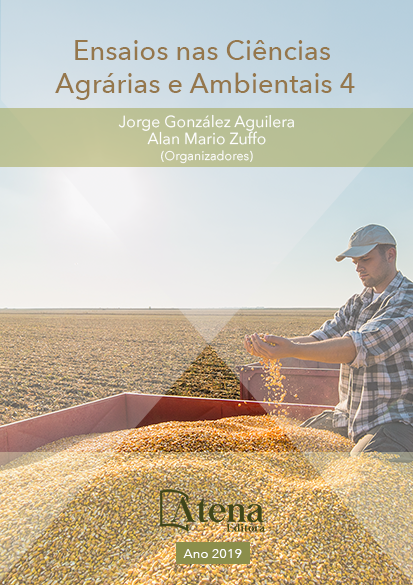
USO DE VANT E PROCESSAMENTO DIGITAL DE IMAGENS NA QUANTIFICAÇÃO DA COBERTURA VEGETAL DO SOLO MANEJADO COM TRITON EM DIFERENTES VELOCIDADES
A análise da cobertura do solo é uma
tarefa relevante para a agricultura de precisão,
evitando o crescimento de plantas invasoras,
reduzindo a perda de água por evaporação
e mantendo capacidade produtiva de áreas
agrícolas. Com isso, objetivou-se nesse
trabalho quantificar a distribuição espacial de
cobertura do solo de uma área experimental da
UFERSA através de imagens digitais obtidas
com veículo aéreo não tripulado, utilizando o
programa computacional Siscob. Através da
classificação das imagens foi feita a avaliação do
percentual de cobertura do solo, antes e depois
do manejo. Foram utilizadas imagens aéreas
capturadas com a câmera de um Drone, marca
DJI Phantom II. O manejo da palha do milho foi
feito com um Triton marca Jan, modelo 3600,
com largura de trabalho de 3,6 m; acoplado a
um trator marca Jonh Deere, modelo 6110J,
operando em três velocidades diferentes de
deslocamento. O delineamento experimental
foi o de blocos inteiramente casualizados,
composto por quatro tratamentos: área sem
manejo, V1, V2 e V3 com nove repetições,
totalizando 36 unidades experimentais. As
variáveis analisadas foram: cobertura da palha
milho, vegetação espontânea, solo descoberto e restos culturais. Os resultados obtidos
foram submetidos à análise de variância e teste de média, Tukey, ao nível de 5% de
probabilidade. Na variável SD houve uma diferença significativa entre os tratamentos:
SM e as velocidades V1, V2 e V3. A área SM teve o percentual de recobrimento do
solo menor que a área com manejo de solo. O tratamento V1 teve a maior taxa de
distribuição da palhada, com 90,5% de solo coberto.
USO DE VANT E PROCESSAMENTO DIGITAL DE IMAGENS NA QUANTIFICAÇÃO DA COBERTURA VEGETAL DO SOLO MANEJADO COM TRITON EM DIFERENTES VELOCIDADES
-
DOI: 10.22533/at.ed.40719160114
-
Palavras-chave: Agricultura de precisão, Fitomassa, Siscob.
-
Keywords: Precision agriculture, Phytomass, Siscob.
-
Abstract:
Soil cover analysis is a relevant task for precision agriculture, avoiding
the growth of invasive plants, reducing the loss of water by evaporation and maintaining
the productive capacity of agricultural areas. The objective of this work was to quantify
the spatial distribution of soil cover of an experimental area of UFERSA through digital
images obtained with unmanned aerial vehicle using the Siscob computer program.
Through the classification of the images was made the evaluation of the percentage of
soil cover, before and after the handling. Aerial images captured using the camera of a
Drone, brand DJI Phantom II were used. The management of the corn straw was done
with a Triton brand Jan, model 3600, with a working width of 3.6 m; coupled to a John
Deere tractor model 6110J, operating at three different shift speeds. The experimental
design was completely randomized blocks, composed of four treatments: unmanaged
area, V1, V2 and V3 with nine replicates, totaling 36 experimental units. The variables
analyzed were: corn straw cover, spontaneous vegetation, uncovered soil and cultural
remains. The results were submitted to analysis of variance and Tukey test, at the
5% probability level. In the JD variable there was a significant difference between the
treatments: UM and velocities V1, V2 and V3. The UM area had the percentage of soil
cover less than the area with soil management. Treatment V1 had the highest straw
distribution rate, with 90.5% of soil covered.
-
Número de páginas: 15
- Ana Beatriz Alves de Araujo


